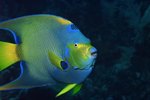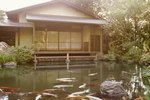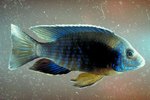
While cichlids are colorful and relatively low-maintenance fish, some Lake Malawi species can exceed 16 inches in length. Smaller versions -- known as dwarfs -- mature at less than 4 inches in length, with large male members of the species less than 5.5 inches. Combining several varieties of Malawi dwarfs will bring color to your tank while maintaining a peaceful environment.
Criteria for Dwarf Cichlids
To be considered a dwarf species, males cannot exceed 14 cm or 5.5 inches in their native environment. Females cannot top out at more than 12 cm or 4.7 inches to be considered a dwarf species. Both males and females become sexually mature when less than 4 inches long. Lake Malawi cichlid species falling within these parameters are few, and are invariably mbuna, also known as rock fish.
Labidochromis Caeruleus
With its bright lemon yellow color and dramatic black fin stripes, Labidochromis caeruleus is one of the most readily-available Malawi dwarfs favored by aquarists. Its generally peaceful temperament makes it compatible with a wide range of other cichlids -- including non-dwarf species -- as it reaches the maximum limits for consideration as a dwarf. The fish goes by the common name yellow lab or electric yellow.
Iodotropheus Sprengerae
The Rusty cichlid (Iodotropheus sprengerae) has a mild temperament and coexists well with other dwarf species. It is one of the easiest of the cichlid species to care for and is herbivorous, unlike most other dwarf mbunas. The rusties have rust-colored faces, dorsal fins and tails, while the rest of their bodies are lavender with some purple barring.
Pseudotropheus Demasoni
With dramatic blue and black striped markings in both males and females of the species, the Pseudotropheus demasoni provides a tank with dramatic color. Males and females are hard to discern from one another, so you should keep more than a dozen to ensure aggression is dispersed among large numbers. Provide plenty of rock caves and hiding places, and do not keep other blue and black barred fish in the tank, or this mbuna will kill them.
Other Blue-Barred Species
Pseudotropheus saulosi has blue males with black bars and yellow females. Frye are pale yellow and take on adult colors at 5 to 6 months old. Saulosi should be kept in groups of six or more, but only the dominant male will have brilliant colors, with lesser males remaining a bluish-gray. The Afra cichlid (Cynotilapia afra) has blue and yellow bodies sectioned by blue vertical stripes. Neither species should be kept with demasoni.
References
Photo Credits
-
Jupiterimages/Photos.com/Getty Images
Writer Bio
Indulging her passion for vacation vagary through the written word on a full-time basis since 2010, travel funster Jodi Thornton-O'Connell guides readers to the unexpected, quirky, and awe-inspiring.




